Highlights
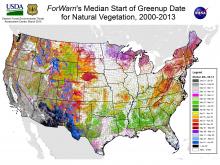 |
The typical start of greenup in natural vegetationThe start of the annual growing season is among the most important climate-sensitive measures that Land Surface Phenology (LSP) products like ForWarn can provide. Warm temperatures can accelerate bud burst, and this can increase exposure to damaging spring frosts, as it did across the Southeastern US in 2007 and 2012. In natural areas, the timing of spring greenup can affect growing season duration and productivity. It can also affect the risk and impacts of disturbances, such as those from... (read more) |
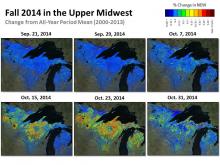 |
Autumnal Hail and Early Browndown in the Upper MidwestIt can be challenging to detect disturbances during seasonal periods of transition such as Fall or Spring in the eastern deciduous forest. The baseline conditions we use to compare with current conditions harbor a lot of normal variation that results from the onset and progression of cold temperatures. In the upper Midwest, Fall is typically reflected by a gradual drop in NDVI during September, then a more rapid decline in October. By the beginning of November during most years, this decline... (read more) |
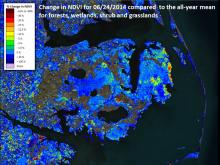 |
Coastal pocosins respond to hurricanes and fireCoastal forests and shrublands can be vulnerable to climate-associated disturbances such as the strong winds and storm surges associated with hurricanes. Because of its extension into the Atlantic, eastern North Carolina is especially vulnerable to such storms, having been hit by several hurricanes during the MODIS period of record (i.e., since 2000). In 2014, Hurricane Arthur struck causing relatively minor damage to forests compared to two earlier events, namely 2003's Hurricane Isabel and... (read more) |
 |
Massive hailstorm destroys Midwestern cropsDuring the first week of June 2014, hail caused significant damage to corn and soybean fields in eastern Nebraska and western Iowa. By June 9th, ForWarn's all-lands product was beginning to show the losses that these storms inflicted across multiple counties despite later than average crop growth in May, and when ForWarn's next product was produced for June 17th, the losses from hail were clearly visible. These maps were made by comparing current NDVI conditions to the all-year mean value... (read more) |
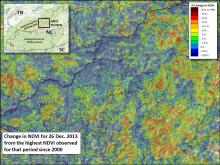 |
Hemlock death transforms Appalachian forestsAcross the Southern Appalachians, Eastern Hemlock has long created an important ecological niche. As these trees are evergreen, they provide year-long cover for wildlife and they cool riparian areas where they tend to grow. Since the mid 2000s, these forests have been in decline due to a lethal non-native insect known as the Hemlock Woolly Adelgid. Like its kin that devastated Fraser Fir forests at higher elevations during the 1960s and 1970s, the Hemlock Woolly Adelgid has been... (read more) |
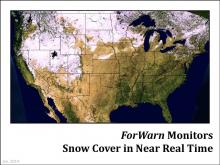 |
Monitoring snow cover in near real timeForWarn's true color product is produced every 8 days at 1km resolution to provide a quality control for ForWarn's disturbance maps. Clouds and snow cover that persists for the entire 24-day MODIS collection window can create the appearance of vegetation disturbance, when it is not. In addition, these true color images show variation in vegetation greenness seasonally and among years. This true color product reveals how snow cover changes over time, and this is particularly... (read more) |
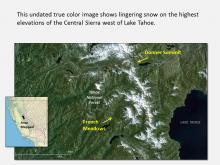 |
Snowpack drives greenup in the SierraYear to year variation in climate has been extreme in California's Sierra Nevada. In particular, low winter snowpack raises concerns about municipal water supplies as reservoirs are fed by spring meltwater. However, low winter snow cover has implications for the region's forests as well. Less snow (and warmer temperatures) often mean an earlier onset of spring and more extended and dryer summer than would otherwise occur. With climate change, warming temperatures are likely to bring earlier... (read more) |
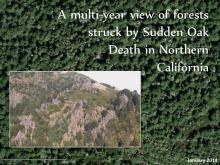 |
A multi-year view of Sudden Oak DeathSudden Oak Death (SOD) is a disease caused by the new pathogen Phytophthora ramorum (Frankel and others, 2013). This spore-producing water mold was first observed when tanoak trees began dying during the mid 1990s in California’s Marin and Santa Cruz Counties. SOD is now known to infect dozens of other species--hosts that help spread the disease--but they do not always succumb. While the SOD pathogen has been detected in nurseries throughout much of the US and in Europe the epicenter of this... (read more) |
 |
Drought, beetles and fire in ColoradoSince 2004, southwestern Colorado's Englemann spruce forests have experienced a severe outbreak of spruce beetles (Dendroctonus rufipennis). Such outbreaks occur episodically, multiple times per century (Anderson et al. 2010). Early research in northern Colorado linked a prior outbreak that occurred in the 1940s and 1950s to wind damaged trees that favored growth in the population of the spruce beetle. More recent research suggests that while local factors may still be important, outbreaks... (read more) |
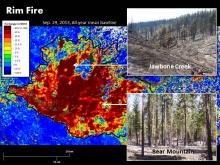 |
Tracking the historic Rim FireThe 2013 Rim Fire burned over a quarter million acres of California's Sierra Nevada, including a portion of the Stanislaus National Forest and Yosemite National Park. It started in mid-August as an illegal campfire after an unusually dry winter and spring. A lower-than-average snowpack melted early, signaling that a hazardous fire season lay ahead. That early season dryness contributed to the below-average productivity in the foothills as shown on ForWarn's June departure map. Once ignited,... (read more) |
